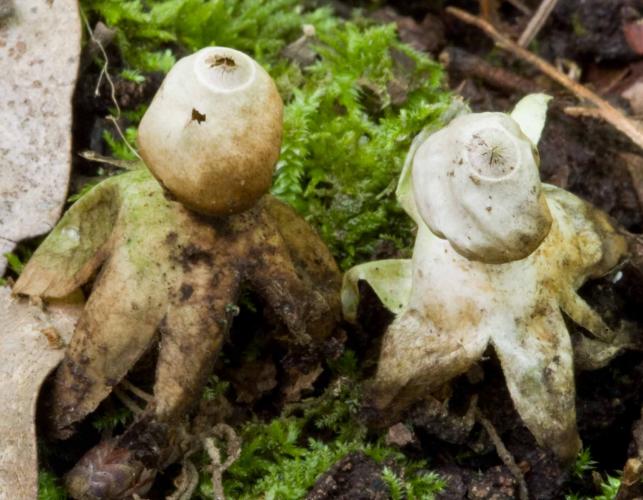
A roundish ball in the center of starlike rays. Grows on the floor of open woods. July–September. Fruiting body star-shaped; composed of a ball (spore sac) surrounded by 4–10 rays, depending on the species. Ball with an opening or hole at the top. Entire mushroom is grayish brown. Spore print brown. Spores magnified are round, warted.
Lookalikes: None in Missouri. You will know when you have found an earthstar, because no other mushroom looks like it.
Ball width: to 1½ inches; ray length: ½–2 inches.

Statewide.
Habitat and Conservation
Grows singly or in groups of up to several on the floor of open woods. Missouri has a few different species of earthstars in the genus Geastrum, but they are similar enough to treat as just "earthstars."
Status
Not edible, but some people like to take home a dried earthstar as a long-lasting, curious souvenir of nature.
Life Cycle
Earthstars spend most of the year as a network of fungal cells (mycelium) that penetrate the soil, digesting decaying organic material. When ready to reproduce, the mycelium develops the “earthstar” aboveground. The “ball” is actually a spore sac. When immature, the spore sac is solid inside, but as it matures the inside changes into a mass of powdery spores. When raindrops hit the ball, the spores puff out from a pore at the top of the sac.
Human Connections
When dry, the arms of the “star” curl up. If you put your dried earthstar in a little water, the rays open up again! Like wildflowers, fungi can be strikingly beautiful—other times, they are breathtakingly strange. Discovering fungi can bring out our innate capacity for awe and wonder.
Ecosystem Connections
Earthstars, like many fungi, live on decaying organic materials. These saprobic fungi play an incredibly important role in breaking down the tough materials living things are made of and returning those nutrients to the soil.






Mushrooms are a lot like plants, but they lack chlorophyll and have to take nutrients from other materials. Mushrooms are neither plants nor animals. They are in a different kingdom — the fungi. Fungi include the familiar mushroom-forming species, plus the yeasts, molds, smuts, and rusts.
Always be cautious when eating edible mushrooms. Be absolutely sure of the ID, and only eat a small amount the first time you try it to avoid a reaction..





















